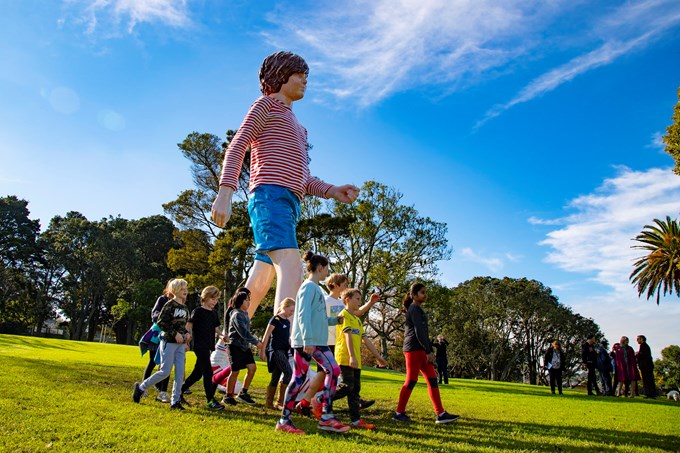A new 5.6-metre-high hyper-realist sculpture, designed by internationally renowned New Zealand-born artist Ronnie van Hout, has arrived at Potters Park in the Auckland suburb of Mt Eden.
Called 'Boy Walking', the artwork depicts a larger-than-life child strolling with purpose. Towering above the streetscape of Dominion Road, the figure walks confidently with a determined stride, head up, focus and an assured smile.
Through Boy Walking, the artist explores the notion of a child transitioning into adulthood.
Curator of contemporary art at the Auckland Art Gallery Natasha Conland says: “It’s great to see art activating our public parks and spaces. An experienced artist like Ronnie van Hout is always going to give us a memorable sculpture; something that sticks in our minds reviving our creative perspectives.”
“As a resident of the Mt Eden/Albert area, I know how much children and families use these spaces and how much they enjoy colour and concepts infiltrating spaces for play.
"There aren’t many artists who understand the importance of humour and play as well as Ronnie van Hout does,” she says.
Construction techniques
Boy Walking was commissioned by Auckland Council in 2018 and fabricated by UAP in Brisbane, Australia over the course of 18 months. The immense sculpture was fabricated using a relatively new process made possible by improvements in 3D technology.
A full-scale mould of the sculpture was cut out of large blocks of expanded polystyrene using a CNC router, driven by 3D information captured from a scaled-up 3D scan of the figure. The moulds were then cast in aluminium and painted.
“This sounds simple, but there are so many steps along the way,” explains van Hout.
“The object is cut into smaller manageable sections, which are cast individually and then welded together to make the finished work. This time-consuming and exacting process sees grinding, filling, sanding and cleaning up at every stage.”
Within the internal structure of the sculpture is a heavy steel armature that is precisely engineered to support the sculpture from loads and prevailing winds and enabled it to be installed perfectly on its footings in the park.
“There is a lot that is not obvious with the manufacture of any public outdoor sculpture,” he says.
“I have certainly learnt a great deal about planning and process, and I am sure New Zealand fabricators can learn to apply some of these new technologies to achieve some remarkable results.”

A new landmark
Potters Park was chosen for its high visibility and its relationship to Dominion Road, one of the city’s key urban transport routes and an iconic Auckland spot with a rich history of pop culture and music.
The site also has special significance to the artist who lived in Mt Eden during his late twenties and early thirties.
Councillor Cathy Casey, Ward Councillor for Albert-Eden-Roskill, says: “Boy Walking is a fantastic new landmark for Potters Park, a place where families gather together to have fun. This is a delightful sculpture about the optimism of youth, something that everyone can identify with.”
“Ronnie van Hout has created a thought-provoking and enjoyable artwork that will put Potters Park on everyone’s must-visit list.”
Van Hout says he expects Boy Walking will provoke a range of responses from the public. “I welcome them all. Love, hate, indifference, anger; they’re all fine with me,” he says.
Born in Christchurch but based in Melbourne since the 2000s, Ronnie van Hout’s provocative works are widely admired and collected across Australasia and the artist currently has 13 works in the collection of the Auckland Art Gallery Toi o Tāmaki.
Boy Walking is his third permanent public artwork after Fallen Robot, which is installed outside the Dowse Art Museum in Lower Hutt and DAYTON at the Monash University Clayton Campus in Melbourne.
Van Hout’s most recent New Zealand project Quasi, which was temporarily installed on the top of the Christchurch Art Gallery, sparked public debate. The work will soon be transferred to a new site in Wellington.
Aucklanders welcomed the new sculpture at an Auckland Council-led gathering in Potters Park last weekend entitled 'New Kid in Town'.
About the artist
Ronnie van Hout was born in Christchurch in 1962 and has lived in Melbourne since the late 1990s. He studied at the University of Canterbury School of Fine Arts, Christchurch and completed an MFA at the RMIT University in Melbourne.
Van Hout is a regular exhibitor and is represented by Station Gallery in Melbourne; Darren Knight Gallery in Sydney; Ivan Anthony Gallery in Auckland; and Hamish McKay Gallery in Wellington.
His work is also held in the collections of Te Papa Tongarewa, Museum of New Zealand, Wellington and the Art Gallery of New South Wales, Sydney.
The artist works across various media including painting, embroidery, video and installation art, and acts out a multitude of public identities and social stereotypes.

Inspiration for Boy Walking was drawn from van Hout’s 1995 Mephitis series of black and white, out-of-focus photographic prints, which are currently held in the Museum of New Zealand, Te Papa Tongarewa.
Mephitis depicts figure moving from outside to inside, and finally into abstraction. One of these photographs, a single figure of a child walking through a New Zealand landscape into an interior, has remained with the artist since.
“The figure seemed so self-determined and forceful, and that appealed to me,” he says.
“In literal terms, this is an eleven or twelve-year-old child, but it could be anyone. We’re all constantly becoming. We’re always learning. Always moving forward.”
Van Hout says he felt ready to bring the concept to life. He says, after many years, he understands the walking figure better now.
“The act of moving forward and the developmental position of the child in a constant state of transition or of permanent becoming; it is the suspension of arrival or a delaying of the end.”


